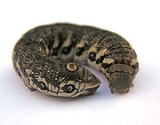
Larva
Overview
A larva is a distinct juvenile form many animal
s undergo before metamorphosis
into adults. Animals with indirect development
such as insect
s, amphibians, or cnidarians typically have a larval phase of their life cycle
. Larva is Latin for "ghost".
The larva's appearance is generally very different from the adult form (e.g. caterpillar
s and butterflies
), and a larva often has unique structures and larval organs that do not occur in the adult form.
Animal
Animals are a major group of multicellular, eukaryotic organisms of the kingdom Animalia or Metazoa. Their body plan eventually becomes fixed as they develop, although some undergo a process of metamorphosis later on in their life. Most animals are motile, meaning they can move spontaneously and...
s undergo before metamorphosis
Metamorphosis
Metamorphosis is a biological process by which an animal physically develops after birth or hatching, involving a conspicuous and relatively abrupt change in the animal's body structure through cell growth and differentiation...
into adults. Animals with indirect development
Developmental biology
Developmental biology is the study of the process by which organisms grow and develop. Modern developmental biology studies the genetic control of cell growth, differentiation and "morphogenesis", which is the process that gives rise to tissues, organs and anatomy.- Related fields of study...
such as insect
Insect
Insects are a class of living creatures within the arthropods that have a chitinous exoskeleton, a three-part body , three pairs of jointed legs, compound eyes, and two antennae...
s, amphibians, or cnidarians typically have a larval phase of their life cycle
Biological life cycle
A life cycle is a period involving all different generations of a species succeeding each other through means of reproduction, whether through asexual reproduction or sexual reproduction...
. Larva is Latin for "ghost".
The larva's appearance is generally very different from the adult form (e.g. caterpillar
Caterpillar
Caterpillars are the larval form of members of the order Lepidoptera . They are mostly herbivorous in food habit, although some species are insectivorous. Caterpillars are voracious feeders and many of them are considered to be pests in agriculture...
s and butterflies
Butterfly
A butterfly is a mainly day-flying insect of the order Lepidoptera, which includes the butterflies and moths. Like other holometabolous insects, the butterfly's life cycle consists of four parts: egg, larva, pupa and adult. Most species are diurnal. Butterflies have large, often brightly coloured...
), and a larva often has unique structures and larval organs that do not occur in the adult form.
Unanswered Questions

